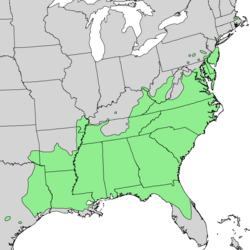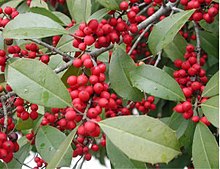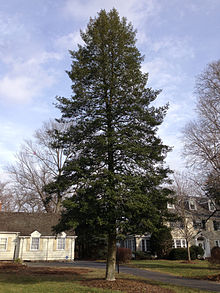American holly
| American holly | ||||||||||||
|---|---|---|---|---|---|---|---|---|---|---|---|---|

Leaves and unripe fruit |
||||||||||||
| Systematics | ||||||||||||
|
||||||||||||
| Scientific name | ||||||||||||
| Ilex opaca | ||||||||||||
| Aiton |
The American holly ( Ilex opaca , English American holly ) is a species of the holly family . It is home to the eastern and southern central states of the United States from the coast of Massachusetts south to central Florida and west to southeast Missouri and eastern Texas .
description
The American holly is a medium-sized (on average 10… 20, otherwise up to 30 meters high) evergreen deciduous tree. Their trunk diameter usually reaches 50 cm, occasionally up to 120 cm. The bark is light gray and rough due to small wart-like growths. The branches are strong, initially green and covered with a rusty down, later smooth and brown. The winter buds are brown, short and blunt or pointed.
The leaves are alternate, 5… 7.5 cm long and 2… 4 cm wide, stiff, yellow-green and dull to matt glossy on top (significantly less glossy than the otherwise similar European holly ( Ilex aquifolium )), often pale yellow on the underside; the edges are curved to several sharp, thorn-like points, with a wedge-shaped base and pointed apex ; the midrib is prominent and flattened, the primary veins are inconspicuous; the petiole is short, strong, furrowed, thickened at the base and provided with a pair of small stipules . The leaves remain on the branches for two to three years and fall off in the spring when they are shed by the growth of new buds.
The flowers are greenish white and small. In late spring they sprout from the leaf axils of young leaves with short inflorescence stalks to form a cerebral umbel or are distributed at the base of young branches. The four sepals are small, imbricat in the bud, tapering, ciliate and long-lived. The corolla is white and consists of four sepal-like petals that are fused at the base and spread at obtuse angles, and is imbricat in the bud. The ovary sits hypogynous . The flower stalk is hairy and has a tiny bract at the base. Like all holly , the species is diocesan , so there are male and female plants and the fruits, characteristic red berries, are only produced by the female plants. One male can pollinate several females . The male flowers have four stamens that sit at the base of the corolla and are offset from the petals. The filaments of the stamens are awl-shaped and much shorter in the sterile form. The dust bags are attached to the back, directed downwards and two-chambered, with the chambers opening lengthways. The pistil of the female flowers has a protruding four-part ovary with two egg cells in each chamber and is rudimentary in the male flowers. One stylus is missing. The scar sits on the ovary and is four-part.
The fruit is a small red stone fruit 6… 12 millimeters in diameter that contains four seeds ; it often remains on the plant until winter. A ratio of three females to one male is ideal for fruit production.
Systematics
Synonyms
The Plant List , a joint venture between the Royal Botanic Gardens (Kew) and the Missouri Botanical Garden , lists the following synonyms:
- Ageria opaca Raf.
- Ilex arenicola Ashe, syn of subsp. arenicola
- Ilex laxiflora Lam., Syn of subsp. laxiflora
Internal system
The following subspecies and varieties are described:
- Ilex opaca subsp. arenicola (Ashe) AE Murray
- Ilex opaca var. Laxiflora (Lam.) Nutt.
- Ilex opaca subsp. opaca
- Ilex opaca var. Opaca
ecology
American holly typically grows in the undergrowth of moist forests in the east-central, southeastern, and south-central United States. It is found in small numbers in the northern part of its range from Cape Cod ( Massachusetts ) south to northern New Jersey (including southern Connecticut and southeastern New York ). It is more common further south in the lowlands on the Atlantic and Gulf coasts of the USA. The branches are short and slender, the roots thick and fleshy. It grows - albeit slowly - in both dry and moist soils. Ilex opaca var. Arenicola ( English scrub holly ) occurs as a shrub in shrub communities in xerothermal (dry-warm) locations on the Florida peninsula. The species is shade tolerant. The ideal mean annual rainfall ranges from 1,020 to 1,650 millimeters.
The flowers are pollinated by insects , including bees , wasps , ants and moths . The berries are supposedly poisonous to humans, but are vital for many bird species when other food sources have dried up. As a tree, the American holly forms a dense crown that provides some bird species with protection from predators and storms. Songbirds such as thrushes , mockingbirds , red-backed mockingbirds , cat thrushes , and cottage warblers occasionally eat the berries.
Cultivation and Use
The wood is very light, hard, finely grained, easy to polish and is used for whip handles, carving and paneling. It can also be colored and used as a substitute for ebony . The density is around 0.58 ... 0.64 g / cm³. Leaking juice is watery and contains a bitter substance that is used as a herbal tonic .
The leaves of the American holly can be used to make a tea-like drink. This tea does not contain caffeine .
Ornamental plant
The American holly is often used in nurseries and tree nurseries as an evergreen ornamental plant ; the planting takes place as a shrub or slowly growing tree. More than 1,000 cultivars were selected, including cold-tolerant forms ('Cobalt', a male cultivar that tolerates temperatures down to −32 ° C), forms with a special growth (e.g. dwarf forms such as 'Cardinal Hedge', a female plant that reaches a maximum height of 1.2 m) and forms with particularly colored and numerous fruits (such as the large-berried 'Yule' and the yellow-fruited 'Canary' and 'Morgan Gold').
Use in winter
American holly is a popular source of decorations during the Advent and Christmas seasons. In English poetry and prose, the European holly ( Ilex aquifolium ) is inextricably linked with Christmas greetings and gifts. This custom has also been adopted in North America, and the native American holly and mistletoe are commonly used to decorate homes and churches.
The European holly is smaller than the American one, but is very similar to it. The leaves of both species are similar in outline, teeth and thorns, but the color of the American species is lighter and the leaves are larger. The American holly was declared the symbol tree of the state of Delaware on May 1, 1939 .
The stone fruit of the American holly appear late in the year due to their maturity period as the last mid-winter; they form an iron food reserve for birds and wild animals. Cedar waxtails will eat any remaining fruit as they migrate north.
Individual evidence
- ↑ a b c d e f H. E. Grelen: lex opaca Ait. - American Holly . USDA , US Forest Service , Southern Research Station. Retrieved June 28, 2019.
- ^ Ilex opaca, 2014 county distribution map . Biota of North America Program. Retrieved June 28, 2019.
- ↑ a b A. Huxley (Ed.): New RHS Dictionary of Gardening . Macmillan, 1992, ISBN 0-333-47494-5 . .
- ↑ a b Ilex opaca . In: Oklahoma Biological Survey . Retrieved June 28, 2019.
- ↑ a b c d e H. L. Keeler: Our Native Trees and How to Identify Them . Charles Scribner's Sons, New York 1900.
- ↑ Plant Database .
- ↑ a b Ilex opaca Aiton . The Plant List. Retrieved June 28, 2019.
- ^ American holly (Ilex opaca) - Climate Change Atlas . Retrieved February 18, 2019.
- ^ Ilex opaca Ait. .
- ↑ Hollies: Caffeine & Antioxidants . Eat the weeds. Retrieved July 1, 2019.
- ^ Delaware Code Title 29 § 305 . Retrieved July 1, 2019.
- ↑ Gil Nelson: The Trees of Florida: A Reference and Field Guide , 2nd Edition, Pineapple Press, 2010.




